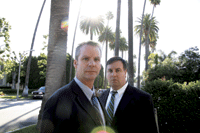Home to $20 million mansions, Beverly Hills, Calif., five years ago had an IT infrastructure that more closely resembled the shack Jed Clampett had before he loaded up his truck and moved to the posh municipality.The city's Novell network was 'very problematic,' said David Schirmer, deputy director of the city's IT Department. 'It was quite common for the network to be down, maybe weekly, for an hour or so.'Beverly Hills' administration was beset by a hodgepodge of paper-based applications and a lack of data sharing, Schirmer said.Keone Kali, the city's IT director, concurred. The city was oversubscribed on its network. Servers couldn't stay up for more than a couple of hours. 'Accounts receivable were done by hand,' Kali said.And almost unbelievably, the city that has come to symbolize luxury and wealth was losing tens of thousands of dollars each year in uncollected utilities and business taxes because of errors in the city's data.Mark Scott, then the city manager, decided this state of affairs wasn't good enough for Beverly Hills. He embarked on a program to make the city's IT infrastructure as shiny and sleek as the cars on Rodeo Drive.The city laid a foundation of sturdy new hardware, including IBM pSeries 6H1 servers running AIX Unix in highly available clusters.The more robust infrastructure enabled the city's IT team to build a central business application that extended to all the city's departments, including Police, Fire, City Hall and Public Works.Called the Online Business Center, the application was based on the city's geographic structure.'About 90 percent of what a municipality does has a geographic component,' Schirmer said.Underlying the OBC is a 3-D application the IT Department wrote in the Java 2 Enterprise Edition environment. Called the Land, Structure, Occupancy addressing model, the application is a means of mapping the history and current data of every location in the city.Using a unique identification number for each point in the city, the LSO can show 'everything about a structure and the land it resides on,' Schirmer said.The LSO also shows a temporal component by listing the history of a location's tenants, including the current ones.The LSO easily integrates with the city's existing geographic information system, which uses ArcGIS, ArcView and ArcIMS products from ESRI of Redlands, Calif.The geographic data is now maintained through one source, which has eliminated errors and redundancies, said Mark Hobson, IT operations manager for the city.'It took a lot of cleanup and data trimming,' Kali said.The OBC offers a central hub for almost all city applications, including permit processing, project management, fee processing, asset management, building permits, inspections data, interdepartmental work orders, customer relationship management and document imaging.The IT Department worked with integrator Edgesoft Inc. of Santa Monica, Calif., to develop the OBC. Beverly Hills owns the OBC product, but the city is working with Edgesoft to relicense it so that other cities can buy it.Buying a product off the shelf would have been more expensive than developing the OBC in-house, and it wouldn't have suited the city's needs as well, Kali said.'Every city that has looked at the OBC says, 'We have to do this,'' said Shan Sundar, Edgesoft president. Around Los Angeles, Burbank is considering adopting the OBC, and Glendale, also has expressed interest in the product.When Beverly Hills officials came to Edgesoft with their ideas, Sundar was surprised at the terminology they used: They wanted to streamline the city's processes, cut costs and improve service to the citizen. "Those are private-sector terms," he said.'Whenever we talk about the OBC or demonstrate it, people are very enthusiastic,' Schirmer said. 'We hit on something that is of value to any municipality that has a public service component.'Fully deployed a little over a year ago, the OBC has saved more than $260,000 in just four departments: Transportation, Public Works, Fire, and Building and Safety.Next year, the city plans to put the OBC on the Internet, where citizens will be able to go online for more services.'Cities don't usually design their own software,' Kali said. 'We're not great at it, so we had to go through a long development process. Perseverance was the key.'Governments, whether rich or poor, are notoriously resistant to change, and Beverly Hills was no different. 'There was a lot of pushback throughout the process, quite honestly,' Kali said. 'But the project came through with shining colors.'To build the OBC, the IT Department had to look over the shoulders of the city's other departments. 'It wasn't easy to do, but it really broke down silos,' Kali said.The OBC transformed 'the culture of this organization, not the other way around,' Kali said.And even though many of the city's residents are rich and famous, Beverly Hills has many of the same struggles as any other city, Schirmer said.Residents insist on having solid funding for highly visible services such as fire, police and public safety. But the IT Department sometimes has to scrape for funds.'We're sort of an afterthought,' Schirmer said.
David Schirmer and Mark Hobson of the Beverly Hills IT Department
Raul Vega







